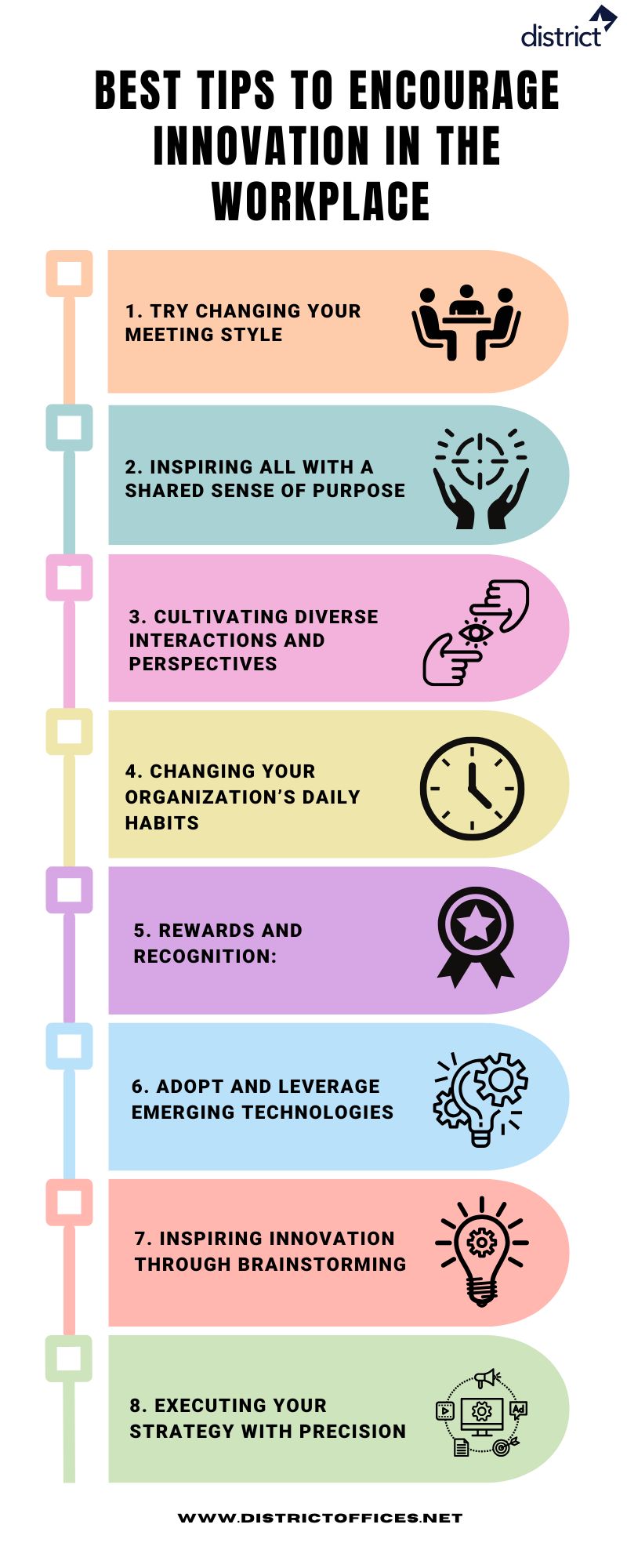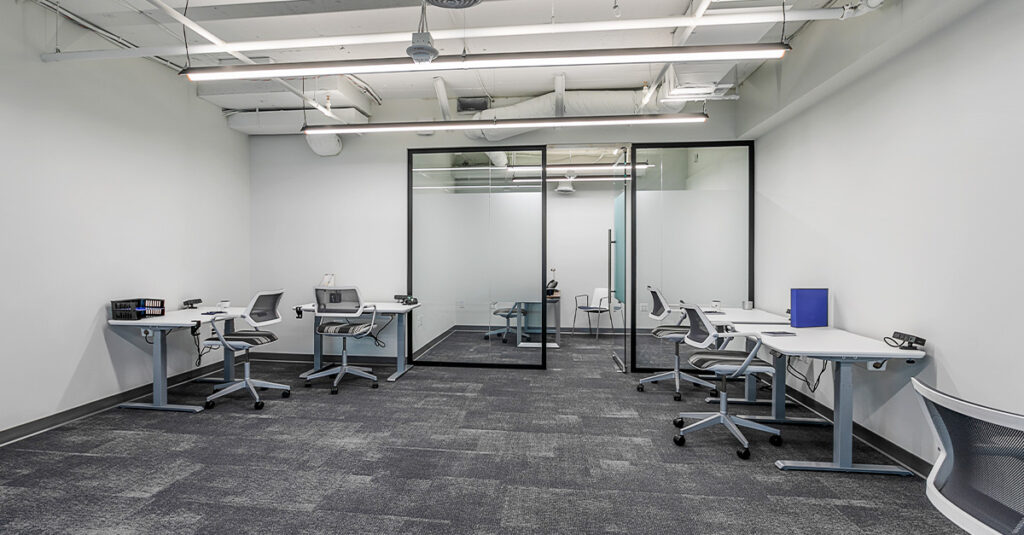Over the past few years, the nature of work has dramatically changed due to the increase in flexibility in the workplace, the evolution of new work ideas and concepts, and other developments. Nevertheless, one aspect of designing an environment that inspires people to come together, engage in face-to-face conversations, and collaborate on innovative projects has a significant impact on the workplace. By supporting and encouraging innovation in the workplace, you can maintain your business’s bottom line and remain competitive.
Creating and introducing something new is the essence of innovation. This could be an innovative technique, product, or service. Innovation often aims to improve or maximize activities, outcomes, and revenue. Motivating your team to be innovative can be incredibly challenging. Innovative and excellent concepts for improving business expansion aren’t generated by brainstorming in a conference room or at your research center. They originate from the employees who often serve your clients and experience difficulties and challenges on a regular basis. It’s still difficult to figure out how to motivate these workers to speak up more.
This blog post explains the importance of workplace innovation, provides guidance and tips on how to encourage it, and explains how to put it into practice.
Table of Contents
ToggleUnderstanding Innovation in the Workplace
Workplace innovation is all about finding better ways to improve how things work, how business is done, and the kind of work culture we create. It’s about making systems smoother, improving the quality of service, or even rethinking how an organization is structured. When a company adopts a culture of innovation, it leads to better results. Employees become more productive, engaged, and perform at their best.
It opens exciting new possibilities for growth and success. Businesses can discover new markets or strengthen their presence in current ones. Encouraging creativity and flexibility also helps employees feel fulfilled while keeping the company adaptable in this fast-changing world.
Also Read : Flexible Workspace or Traditional Offices – Which One to Choose?
Why is Workplace Innovation Important?
Innovation in the workplace has a very important role to play. It can help businesses from becoming stagnant and ensure that they grow with the upcoming market trends. It doesn’t
matter whether your business is small or large, making innovation part of daily operations has clear advantages like competitiveness, growth, etc.
Creating a creative culture in the workplace allows team members to try out new ideas and discover unique solutions to challenges. This enhances the company’s strategy and makes the workplace more attractive, especially for those who thrive in a lively and imaginative setting.
Several other advantages of innovation in the workplace are:
- Becoming more appealing to potential new hires
- Increasing the internal processes’ efficiency
- Innovation in the workplace promotes a continuous improvement culture.
- Improving your workplace environment
- Allowing quick response to changing market conditions and client needs
- Boosting cooperation and engagement among employees
- Innovative companies always have a competitive advantage
- Improved operational efficiency and cost savings are often the outcomes of streamlined procedures and innovative technologies.
- Businesses with more creative thinking are likely to develop new, workable solutions and services.
Also Read: Work Smarter: Leverage Administrative Support in Your Coworking Space
Best Tips to Encourage Innovation in the Workplace
To encourage innovation in workplace, it’s very important to understand the different elements of the innovation process and to communicate them effectively. As managers and leaders, it’s your role to motivate your team to pursue opportunities for better creativity and innovation in their work. Here are some of the best tips to promote a creative and innovative environment at workplace:

1) Try Changing Your Meeting Style
You can arrange meetings that aren’t the same as the ones your team is used to. One possibility is to organize a stand-up meeting, in which attendees are encouraged to stand. When we stand, our energy shifts. It should come as no surprise that a meeting’s energy changes as well with this. You should organize one stand-up meeting out of several
sessions throughout the day and see how momentum, excitement, and action improves.
2) Inspiring All with a Shared Sense of Purpose
In many organizations, motivation and a sense of purpose often diminish as you go further down the management hierarchy. However, leaders who have successfully developed a strong, purpose-driven culture within their organizations are able to inspire individuals at all levels. Others will naturally be attracted in when everyone in the office uses creativity and innovation. Even the most reserved team members will begin to contribute, or at the very least, engage in original ideas. You can put something inspiring that captures attention on notice and make it the center of attention in the office right away.
3) Cultivating Diverse Interactions and Perspectives
Top-tier companies set themselves apart by cultivating a culture that encourages unplanned cooperation among their employees. This includes creating an inclusive and diverse work environment and motivating team members to share their unique insights and experiences. These different connections not only improve the daily work atmosphere but also prove valuable during tough times. Moreover, you can inspire employees to explore innovative ideas and viewpoints. This becomes possible by offering opportunities for professional development and networking with individuals from different industries and backgrounds.
4) Changing Your Organization’s Daily Habits
Challenge yourself to manage situations differently. It’s important to move out of box and cultivate an inventive culture that generates new ideas and solutions. For example, every Friday you can start by setting aside one to two hours to let employees come up with fresh ideas on their own, and then later, add to them using findings from your research and study. By beginning with a well-defined structure and set aside time for it, you can progressively create a culture that encourages innovation, experimentation, and constant improvement. You can also implement other ideas for your team that you like, and think can be innovative.
5) Rewards and Recognition: Boost Energy by Acknowledging All
Acknowledging employees for their efforts as well as their results encourage innovation in the workplace. As company leaders, it is your responsibility to encourage employees who
bring in fresh ideas to work toward organizational goals by rewarding and praising them. This provides employees in the company a new upliftment and motivates them to carry on giving. It is important that you express gratitude for all suggestions, whether they are implemented in the workplace. You can also use gift cards, online platforms for rewards and recognition, awards programs, etc. to do this.
6) Adopt and Leverage Emerging Technologies
The right technology and digital tools can make a real difference in boosting productivity, improving collaboration, and fueling innovation in the workplace. Innovation is not about having great ideas or talent—when employees have the right tools, processes, and support, they can find ways to innovate and improve. Tools like collaboration platforms, workplace experience software, scheduling apps, and management systems can help employees focus on what really counts. This helps in making meaningful changes that drive the business forward.
7) Inspiring Innovation Through Brainstorming
You can even plan outings or lunch together with the team to help them inspire and become more comfortable with each other. You should always try to have brainstorming sessions in a new place and different environment. Sometimes sitting in an unfamiliar environment can lead to more creative solutions. Finding new spaces can bring fresh energy and liveliness to the team so that teams can collaborate on fresh ideas and tend to be more productive.
8) Executing Your Strategy with Precision
Innovation only works when implemented. For this, it is especially important to plan the course of action needed to turn your idea into real-world results. You need to make sure that your team has access to the right resources, time, and tools. Without proper execution, even the best ideas fail. If you feel like substantial changes would take time and are not possible to execute at once. Then, start with the small steps that help you deliver immediate value. Small innovations are easy to execute plus they pave the path for larger, more ambitious changes down the road.
Quick Takeaways:
- Innovation in the workplace is particularly important, it promotes a culture of creativity, teamwork, and ongoing development while also driving a positive change.
- Innovative thinking and teamwork are encouraged in the hybrid workplace by proper technology and tools.
- Office collaboration capabilities enable team members to be creative and innovative, no matter where they are.
- Workplace innovation can be hampered by a culture of risk repulsion, resistance to change, communication problems, and a lack of resources.
Final Thoughts
In today’s competitive landscape, innovation is a fundamental driver of productivity and success. There is no doubt that everyone wishes to create an innovation culture. But building a culture of innovation takes dedication, time, and support from both – employees and the leaders as well. You can improve your organization’s future success by encouraging lifelong learning, empowering employees with autonomy, or cultivating a collaborative culture. Follow the strategies discussed in this blog, and watch your workplace become a thriving hub of innovation and productivity. These strategies will help you create an environment where productivity grows, and innovative ideas are born. Immerse yourself in the world of workplace innovation and see for your business what it has to offer.
FAQs (Frequently Asked Questions)
1) What is workplace innovation, and how can organizations effectively encourage it?
Innovation in the workplace involves bringing in and applying innovative ideas, processes, products, or services to boost an organization’s efficiency, productivity, and culture. It is about thinking creatively and finding unique solutions to tackle challenges faced by your business. This might include adopting modern technologies, promoting open communication within teams, adopting sustainable practices, or designing collaborative workplaces. Workplace innovation can come from employees at all levels and often leads to competitive advantages, greater profitability, and improved employee satisfaction. To encourage innovation, companies can offer incentives, create a psychologically safe environment, support side projects, organize workshops, and provide opportunities for skill development.
2) Why is it essential for businesses to invest in workplace innovation?
In the business world, challenges are unavoidable, and having an innovative mindset can help you navigate these obstacles while helping growth and success. Having a culture centered around innovation can enhance productivity and efficiency while increasing employee engagement. Furthermore, companies with innovative cultures tend to have a stronger market position as well as a more positive brand.
3) In what ways can recognizing and rewarding innovation enhance organizational success?
Employee engagement can be increased through a rewards and recognition program, which leads to increased productivity and retention for the company. It motivates employees to continue generating creative ideas. Creating a culture of appreciation, increasing employee morale, and setting positive examples for others encourages employees to keep their ideas and solutions coming up.
4) What specific actions can leaders adopt to encourage innovation in their teams?
Leaders can encourage innovation by being open to current ideas, promoting a culture of experimentation, providing resources for creativity, supporting risk-taking, and acknowledging and celebrating innovative contributions. Diversity and inclusion should be actively promoted in the workplace to enhance creativity. Plus, to cultivate creative thinking and problem-solving skills, leaders should also invest in training programs.

















































































